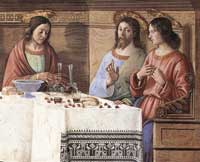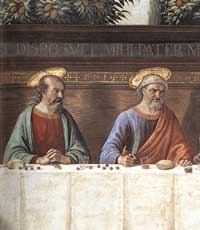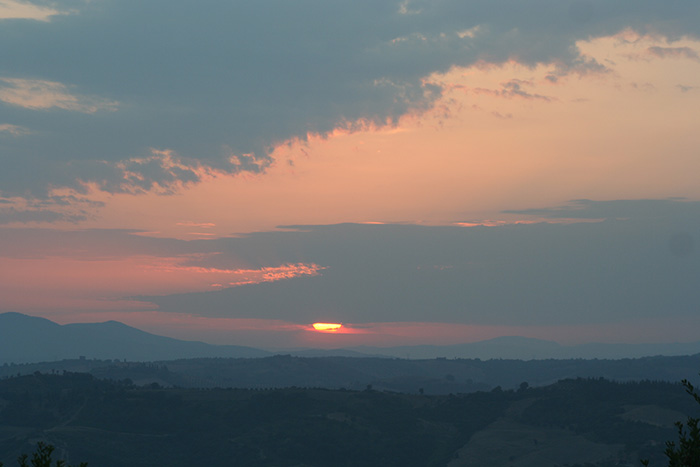| |
|
San Marco is the current name of one of the most important religious complex in Florence.
The huge architectonical complex is set out by the former Monastery of San Marco and the Church after its name.
In 1866 the Florentine Municipality decided to convert a big part of the huge religious complex into a Museum. In 1869, when the subsequent modifies and restorations were ended, it was opened to the public. The Museo di San Marco hosts the main collection of sacred art in Florence.
It is located in Piazza San Marco, in the hub of the university quarter, in the neighbourhood of the Galleria dell’Accademia.
In the 12th century the present site of the Monastery of San Marco belonged to a Monastery of the ancient Vallombrosan monastic order. Later, it became the site of a Sylvestrine Convent (a monastic line of the Benedictine order). In the third decade of the 15th century, when the Dominican moved their main site from Fiesole to Florence with the support of Cosimo the Elder - who financed as well the whole rebuilding work of the Monastery- they took the place of the Sylvestrine order in the recently reconstructed and enlarged Monastery.
The reconstruction of the religious site was carried on in 1436 by the famous Florentine architect and sculptor Michelozzo di Bartolommeo (1396-1472), the entrusted architect of Cosimo the Elder, who had been a brilliant disciple of Donatello and, later, his assistant.
Michelozzo respected to the utmost in his project the ideal architectonical Renaissance features of Brunelleschi. Besides the architectonic planning and the conduction of the work, Michellozo stand out also for his sculpturing works within the religious complex.
Cosimo the Elder commissioned the ornamentation of the Monastery from the Dominican friar and great painter of the early Renaissance Fra Angelico (1400 ca - 1455).
The Dominican site was consecrated in 1443 and became the setting of passionate religious, intellectual and artistic activities headed by some illustrious friars such as: the above mentioned Tuscan painter Fra Angelico (born Guido di Pietro) who started as a painter when he was only 17 years old. A year later he entered into religion in the former Dominican Monastery in Fiesole and resided in the Monastery of San Marco between 1436 and 1445;
by St. Antonino da Firenze (born Antonino Pierozzi) Archbishop of Florence, between 1446 and 1459, and later by the theologian and thinker Fra Girolamo Savonarola (1452-1498), who was nominated prior of the Monastery in1491 and, between 1494 and 1498, he became the grey eminence of the Republic of Florence. In 1498, according to the sentence pronounced by the Inquisition Court, Savonarola was condemned to die at the stake together with other two Dominican friars, his faithful Fra Silvestro and Fra Domenico da Pescia. On the 23rd May 1498 they were executed in the Florentine Piazza della Signoria. In the following centuries a commemorative plaque was set in the same place where the scaffold had been erected.
Fra Angelico, occasionally helped by his Dominican disciples and assistants, painted an infinite series of frescoes nourished to blaze and to strength the Catholic faith of the monks and visitors. They can be considered as a great painted prayer.
The frescoes were painted in the Cloister, in the Capitular Hall, in the Sacristy, in the Library and in the accesses or in the indoors of the forty-two cells intended for the monks rest and in the apartments intended to host some illustrious persons. In the 20th century were assembled in the Museum other paintings by Fra Angelico, coming from different religious sites, private collections, etc. They constitute an extraordinary collection of artworks created by the great Tuscan artist.
Among them the most outstanding works are:
The altar pieces: “Pala di San Marco”; “Pala di Annalena” and the masterpiece: “La Deposizione” (a panel included in “Pala Strozzi”) hosted in the former Hospice,
“The Linaioli Tabernacle”, a teamwork by Fra Angelico and the illustrious Florentine sculptor, goldsmith, architect and art writer Lorenzo Ghiberti (1378-1455) which contains: “Madonna e Bambino in trono con S. Giovanni Battista e S. Marco”; “Il Predicamento di San Pietro” ed “Il Martirio di S. Marco”.
The internal of the treasured “Armadio degli Argenti”, is composed of a panels cycle depicting all the episodes from Jesus life. Among them: the masterpieces known as “L’Annunciazione della Vergine” and “La Fuga in Egitto”.
On the other hand: “La Natività”; “La Resurrezione”; “L’Incoronazione della Vergine” and “La Chiamata di Pietro”, which is an illuminated tiny painting within the small missal nº 558 of the Monastery.
The masterpieces called: “La Crocifissione”, hosted in the Capitular Hall; “San Domenico adorante la Croce” is the largest fresco displayed in the cloister on the first floor; “Il Sepellio” is housed in cell nº 2; “La Derisione di Cristo” is displayed on the external wall to the cells nº 7 and 8; “L’Annunciazione” is displayed in the access of cell nº 32; “La Madonna delle Ombre” is displayed on the external wall to the cells nº 25 and 26; “La Madonna in Trono con due santi” is displayed in the Dormitory passage.
“Noli me Tangere”, “Le Tre Marie alla Tomba”, “L’Adorazione dei Magi”, “La Trasfigurazione”, “Il Cammino ad Emmaus” and many versions of “La Crocefissione” are respectively hosted within the cells.
|
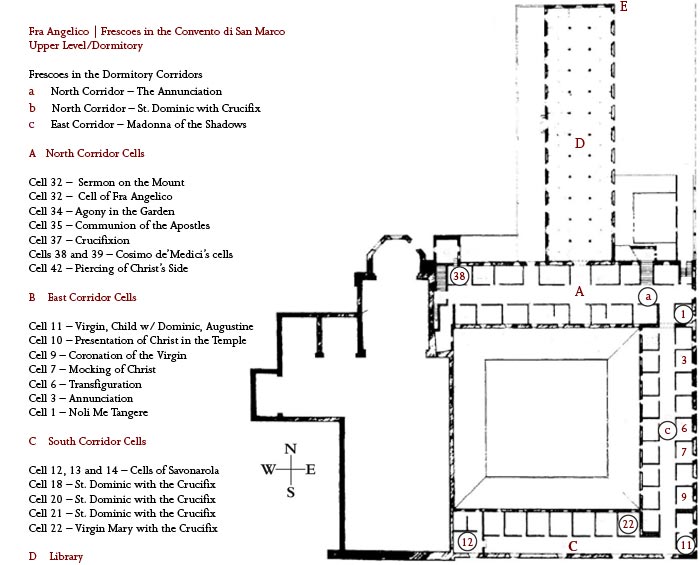
|
The Museum of San Marco
|
|
|
The new largeness given by Michelozzo to the present Museum included two floors. The first one was opened to the visitors and the second one was intended for the monastic retreat.
On the right of the doorway to the refined Cloister of S. Antonino da Firenze, with and ancient cedar standing in its hub, there is the opening to the Hospice, a big structure which was once used to provide shelter to the pilgrims or to house special guests. The Cloister was beautifully frescoed by the prestigious mannerist Tuscan painter Bernardino Pocetti at the beginning of the 17th century.
Close to the former Hospice there is the imposing Refectory, which hosts several artworks from the 16th to the 18th century. One of the walls was entirely frescoed by Giovanni Antonio Sogliani (1492-1544) an eminent painter from the pictorial Tuscan school of the Counter Reformation. The enormous fresco depicts “La Providenza dei Domenicani”. Another wall houses artworks by Mariotto Albertinelli, byname of Mariotto di Bigio di Bindo Albertinelli (1474-1515). He was a well-known Florentine painter from the High Renaissance, very much influenced by the spirit of Fra Angelico and by the formal features of Raffaello.
Just outside of the Refectory is the marvellous polychromatic terracotta sculptured group originated by the celebrated Florentine goldsmith, sculptor and potter Lucca Della Robbia (1388 ca.-1482), called the “Madonna col Bambino”.
Close to the Refectory is the “Sala del Lavabo” which hosts some outstanding frescoes painted by Fra Angelico and by the brilliant Paolo Uccello (1397-1445) who in 1436 ca. painted there the touching “Uomo di dolori tra la Vergine e S. Giovanni Evangelista”. Some years before Uccello had been also commissioned from the Church of San Marco to reconstruct the mosaics adorning it indoors which had been seriously damaged by a fire in 1426.
From the “Sala del Lavabo” there is the entrance to the large room called “Sala di Fra Bartolomeo”, devoted to the work of the famous Florentine painter Fra Bartolomeo Baccio della Porta (1475-1587) who in his adolescence was been a brilliant pupil of Cosimo Roselli. Fra Bartolomeo entered into religion in the Dominican order when he was 18 years old, guided by his admiration for Girolamo Savonarola. In 1504 he retook his pictorial activity, remaining loyal to the thought of Savonarola as he manifested in the religious eloquence and in the ideal simplicity of his works.
Next is another large room called “Sala di Alessio Baldovinetti”, which houses the famous “Stendardo” (a large banner) created by the celebrated Tuscan painter from the early Renaissance Alessio Baldovinetti (1425-1499) who in his youth was been an advantaged disciple of Fra Angelico and Domenico Veneziano. The “Stendardo”, which was carried in procession for ages, portraits San Antonino da Firenze in adoration of the Crucifix.
The Capitular Hall is located opposite to the Cloister of S. Antonino da Firenze. Its indoors are presided by the outstanding “Crucifixion” by Fra Angelico.
Next is the “Sala del Cenacolo” (the small Refectory) which is dominated by a masterpiece created by the great Florentine painter Domenico Ghirlandaio (1449-1494): “The Last Supper”, the last (from 1486) and small fresco (400 x 800 cm) from the three one created by Ghirlandaio representing the same subject.
His first “Last Supper” was painted in 1476. It is displayed in the Refectory of the Badia dei Santi Michele e Biagio in Passignano sul Trasimeno (Tuscany). The second one was created in 1480 and is hosted in the Church of Ognissanti in Florence.
Nearby the “Sala del Cenacolo” is the “Foresteria” composed of some rooms intended to depict the ancient Florence. They host fragments of sculpturing and architectonical works from the historical centre of the city which were demolished during the second half of the 19th century, as well as a precious collection of objects and paintings rescued from the 19th century destruction attempt of the Monastery. They also house an exclusive collection of ancient bells.
On the upper floor, which is constructed in accordance to the parameters of the Cloister of S. Antonino da Firenze, are located the cells of the friars who resided in the former Monastery.
Each cell hosts a fresco of religious subject painted by Fra Angelico.
Cells 12 to 15 were the austere cells intended to the study and the rest of Fra Girolamo Savonarola. They host two masterpieces by Fra Angelico: a wonderful version of his famed “Annunciazione” and “La Trasfigurazione”, as well as the celebrated portrait of Savonarola painted by Fra Bartolomeo in 1498. The cells house also several relics of the late-lamented utopian thinker.
The largest cells 38 and 39 were reserved for Cosimo the Elder when the founder of the Medici dynasty recoiled in the Monastery to meditate and find spiritual peace among those paradisiacal walls.
The entrance to the superb Library of San Marco is located at the beginning of the ample passage between the cells 42 and 43.
It was as well designed by Michelozzo with the architectonical features of a colonnaded hall. The Library, considered an example of the ideal Renaissance architecture, is composed of an ample central nave and two narrower laterals. Once it contained 64 worktables intended to the study of the friars and guests. Currently it displays an outstanding collection of illuminated manuscripts, incunabula, ancient books of philosophical and scientific matter, old Greek and Latin grammars and poetical works and a large collection of ancient precious missals, all of them created in the Monastery.
The Library of San Marco has been the first public one in Europe.
In the times of Lorenzo the Magnificent it was the preferred intellectual site in Florence. Furthermore than Lorenzo de Medici it was frequented by eminent persons such as the philosopher Pico della Mirandola (1463 -1494), who from 1488 ca. worked in Library invited by Lorenzo de Magnificent. In the last years of his life he entered in religion in the Dominican Monastery of San Marco.
Other illustrious erudite who was linked to the Library was the Tuscan grammarian, poet and writer Agnolo Poliziano (1454-1494). In his adolescence, between 1469 and 1473, he translated from Greek into Latin “The Iliad”. Lorenzo the Magnificent remained so admired by this work to concede him, in 1473, the privilege of working in the Library. When Poliziano was 21 years old was nominated instructor of Piero de Medici, son of Lorenzo.
The Church of San Marco
It reconstruction was projected as well by Michelozzo, being consecrated by Pope Eugenio IV in 1443. Its indoors are composed by a sole nave flanked by beautiful chapels which were designed in the mid of the 16th century by the celebrated Flemish sculptor Jean de Boulogne (1529-1608), cordially called Giambologna in Italy where he resided the most part of his life.
The pretty carved ceiling was made in the second half of the 17th century. Around 1680 the Church was renewed by the well-known Florentine architect Pier Francesco Salviani (1620-1685) while the reconstruction of the present Neo-Classical façade was carried on in 1778 ca.
In the counter-façade is set an imposing wooden crucifix from the 14th century while the crucifix placed on the High Altar is a masterpiece by Fra Angelico, created between 1425 and 1428.
“S. Tommaso in preghiera” (from 1594 ca.) which is placed on the first altar to the right, is a splendid canvas by the worldwide celebrated Florentine artist Santi di Tito (1536-1603) who played an important role in the transition from Mannerism to the Baroque in Florence, being also one of the leading painters of the Counter Reformation in the capital city of Tuscany.
On the second altar is set the “Madonna e santi” an elegant painting by Fra Bartolomeo.
Among the chapels designed by Jean de Boulogne in the Church of San Marco stand out the Cappella Salviati and the Cappella del Sacramento.
The first one was commissioned from him by the Salviati family who became related by marriage to the Medici one, through the nuptials of Giacomo Salviati with Lucrezia de Medici. Jean de Boulogne terminated in 1589 the work of the Chapel. Its magnificent dome was frescoed by the refined mannerist painter Bernardino Poccetti (1548-1612).
The indoors of the Salviati Chapel were frescoed by the renowned Florentine painter Domenico Passignano (known as “Il Cresti” or as “Il Passignano”) with a fresco cycle representing “Il Trasferimento ed il Funerale di S.Antonino Perozzi” (the translation and funeral of S. Antonino Perozzi). Domenico Passignano was born in 1558 and died in 1638. Although he was born in Passignano, in the proximities of Florence, he belonged to the Venetian school and was very much influenced by the art of Tintoretto. In Florence he became one of the entrusted painters and decorators of Ferdinando I de Medici, Grand Duke of Tuscany.
The indoors of the Cappella del Sacramento were frescoed by Bernardino Pocetti. The Chapel included a series of outstanding pictures created in the most part by Tuscan artists from the 16th to 17th century: Santi di Tito, Jacopo da Empoli, Daniele Crespi (born in Milan), Francesco Curradi and Francesco Morandini.
The Church of San Marco houses as well the tombs of some illustrious persons. Among them, are the sepulchres of Pico della Mirandola and of Agnolo Poliziano.
|
|
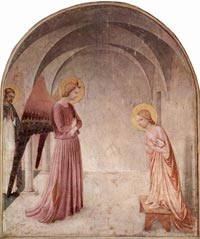
Fra Angelico, Annunciation
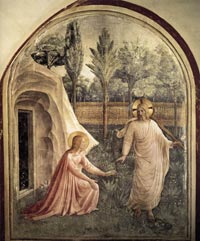
Fra Angelico, Noli Me Tangere
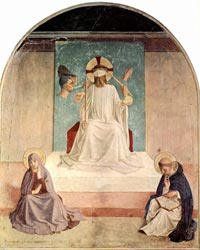
Fra Angelico, The Mocking of Christ
(cell 7)
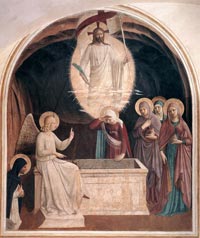
Fra Angelico, Resurrection of Christ and Women at the Tomb (Cell 8)
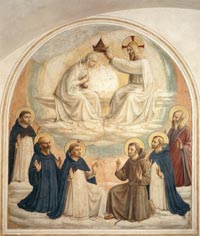
Fra Angelico, Coronation of the Virgin (Cell 9)
|
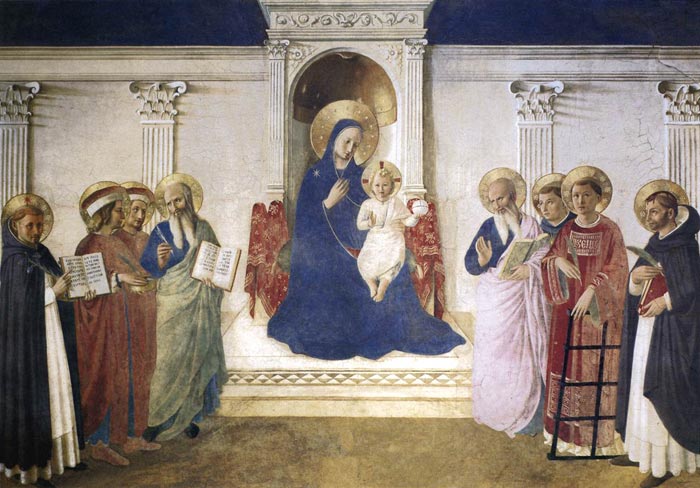 |
Fra Angelico, Sacra Conversazione, c. 1443, fresco, 195 x 273 cm, Convento di San Marco, Florence
|
| |
|
|
|
| |
|
Paintings for the Armadio degli Argenti
|
|
|
Fra Angelico was entirely a painter of religious pictures. To the popular imagination, he was humble, pious and cloistered – Vasari’s saintly friar who ‘never took up his brush without offering a prayer and who could not paint a crucifixion without tears streaming down his cheeks’. The paintings of the Armadio degli Argenti show episodes from the New Testament.
This panel is part of a series, now consisting of thirty-five panels, commissioned by Piero de Medici for the doors of a cupboard at the San Marco convent, and depicting scenes from the life of Christ.
Art in Tuscany | Fra Angelico | Paintings for the Armadio degli Argenti (1451-52) |
|
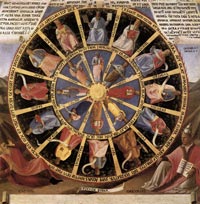 Mystic Wheel (The Vision of Ezekiel), 1451-52, Museo di San Marco, Florence |
| |
|
|
|
|
|
Domenico Ghirlandaio, Last Supper
|
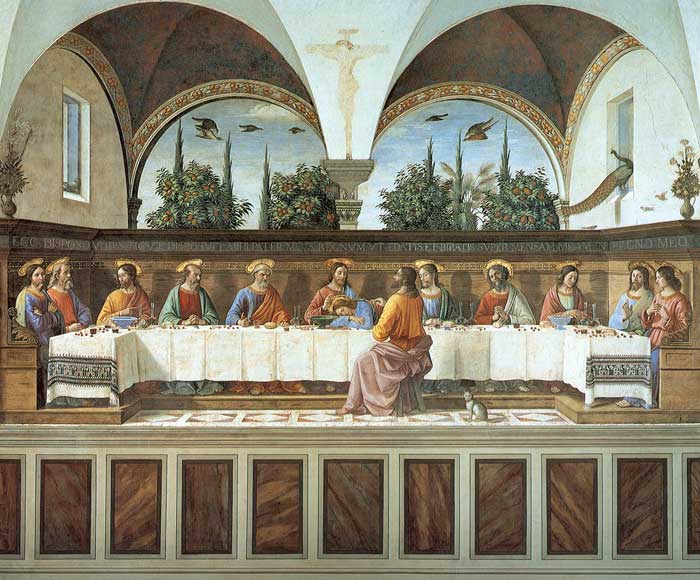 |
Ghirlandaio, Last Supper, c. 1486, fresco, 400 x 800 cm, San Marco, Florence
|
The last surviving version of Ghirlandaio's Last Supper is in the refectory of the hostel of the San Marco convent.
It is pleasing to observe that chronicler's narration of his city and the rich bourgeois inhabitants who enlivened it in the middle of the 15th century. It is typical of the work of Ghirlandaio, who certainly sketched out the drawing and, at times, participated directly in its execution. Rendered without resorting to dramatic force, it reveals a serenity and great faithfulness to life. Note the impassive Judas, seated in front of Jesus and almost conversing with him. The supper takes place at a large table with a bright tablecloth, embroidered at the edges. Nothing about it is casual; the crockery, the decanters, the knives, the bread and the cherries, are carefully arranged in front of every guest.
With customary ease, Ghirlandaio fills the lunettes with large trees and birds in flight against a bright sky whose light is reflected onto the right-hand wall where an open window frames a perching peacock. The rest is in shadow. Two flower-displays complete the frame which encloses the space. A cat, waiting patiently for a hoped-for scrap of meat, lends a touch of intimacy and domesticity that is rarely lacking in Ghirlandaio.
The apostles react in a variety of ways to Christ's words that He will be betrayed. While the disciple on the right appears to be asking: "It is me, Lord, who will betray you?", the one on the left is gazing sadly at his hands. The artist offers additional proof of his sensitive powers of observation through his playful depiction of the glass vessels on the table: through one glass carafe, we can see hands resting on the table behind, and through another glass we can see a carafe.
Art in Tuscany | Ghirlandaio, Last Supper
|
|
|
|
|
|
![]()
![]()
![]()
![]()
![]()










